Loading...
Searching...
No Matches
Visualization Tools
2dCompImage
Usage: 2dCompImage <imageA>.pgm <imageB>.pgm –imageError <name>Allowed options are :
Example: Typical use example: You should obtain such a visualisation:
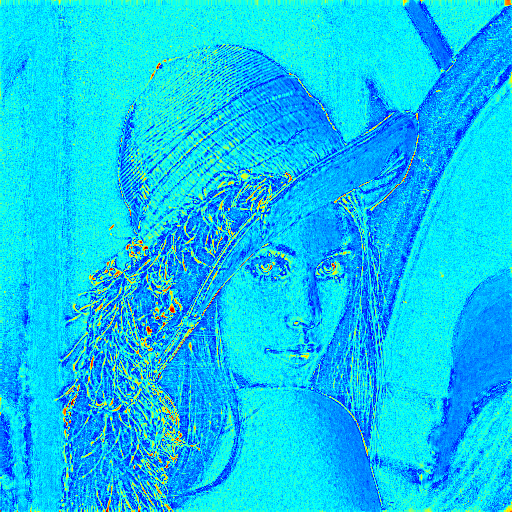
Positionals:
1 TEXT:FILE REQUIRED Input filename of image A.
2 TEXT:FILE REQUIRED Input filename of image B.
Options:
-h,--help Print this help message and exit
-a,--imageA TEXT:FILE REQUIRED Input filename of image A.
-b,--imageB TEXT:FILE REQUIRED Input filename of image B.
-e,--imageError TEXT Output error image basename (will generate two images <basename>MSE.ppm and <basename>MAE.ppm).
-S,--setMaxColorValueMSE INT Set the maximal color value for the scale display of MSE (else the scale is set the maximal MSE value).
-A,--setMaxColorValueMAE INT Set the maximal color value for the scale display of MAE (else the scale is set from the maximal MAE value).
2dCompImage imageA.pgm imageB.pgm -e errorImage -S 100

resulting visualisation of absolute error between two images.
- See also
- 2dCompImage.cpp
3dCompSurfelData
Usage: 3dCompSurfelData [input] [reference]Allowed options are:
Example: To use this tools we need first to have two differents surfel set with an attribute to be compared. We can use for instance the curvature from the sample file of DGtal/examples/samples/cat10.vol: You should obtain such a visualisation:
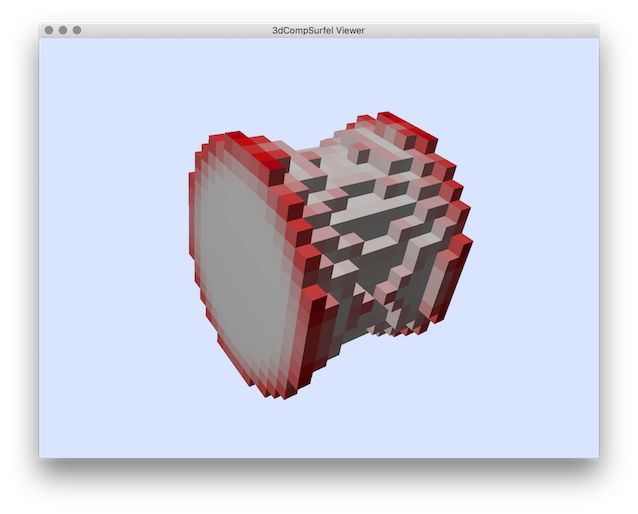
Positionals:
1 TEXT:FILE REQUIRED input file: sdpa (sequence of discrete points with attribute)
s TEXT:FILE input file: sdpa (sequence of discrete points with attribute)
Optionals:
-h,--help Print this help message and exit
-i,--input TEXT:FILE REQUIRED input file: sdpa (sequence of discrete points with attribute)
-r,--reference TEXT:FILE REQUIRED input file: sdpa (sequence of discrete points with attribute)
-l,--compAccordingLabels apply the comparisos only on points with same labels (by default fifth colomn)
-a,--drawSurfelAssociations Draw the surfel association.
-o,--fileMeasureOutput TEXT specify the output file to store (append) the error stats else the result is given to std output.
-n,--noWindows Don't display Viewer windows.
-d,--doSnapShotAndExit TEXT save display snapshot into file. Notes that the camera setting is set by default according the last saved configuration (use SHIFT+Key_M to save current camera setting in the Viewer3D).
--fixMaxColorValue FLOAT fix the maximal color value for the scale error display (else the scale is set from the maximal value)
--labelIndex UINT set the index of the label (by default set to 4)
--SDPindex UINT x 4 specify the sdp index (by default 0,1,2,3).
# generating another input vol file using tutorial example (eroded.vol):
$ $DGtal/build/examples/tutorial-examples/FMMErosion
# Estimate curvature using other DGtalTools program:
$ 3dCurvatureViewer -i $DGtal/examples/samples/cat10.vol -r 3 --exportOnly -d curvatureCat10R3.dat
$ 3dCurvatureViewer -i eroded.vol -r 3 --exportOnly -d curvatureCat10ErodedR3.dat
Now we compare the different curvature values from the two shapes:
./visualisation/3dCompSurfelData curvatureCat10ErodedR3.dat curvatureCat10R3.dat --fixMaxColorValue 1.0 -o statMeasures.dat

resulting visualisation of curvature comparison.
3dCurvatureViewer
Vol file viewer, with curvature (mean or Gaussian, see parameters) information on surface. Curvature values are displayed using a colormap (Viridis by default). The colormap and scale can be changed in the Polyscope interface (press W).Uses IntegralInvariantCurvatureEstimation
Below are the different available modes: You should obtain such a visualisation:
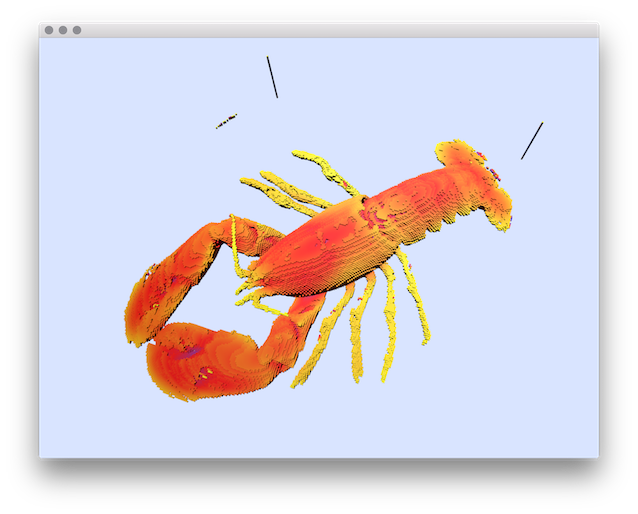
- See also
- related article: Coeurjolly, D.; Lachaud, J.O; Levallois, J., (2013). Integral based Curvature Estimators in Digital Geometry. DGCI 2013. Retrieved from https://liris.cnrs.fr/publis/?id=5866
Usage: 3dCurvatureViewer -i file.vol –radius 5 –mode meanAllowed options are:
Positionals:
1 TEXT:FILE REQUIRED vol file (.vol, .longvol .p3d, .pgm3d and if DGTAL_WITH_ITK is selected: dicom, dcm, mha, mhd). For longvol, dicom, dcm, mha or mhd formats, the input values are linearly scaled between 0 and 255.
Options:
-h,--help Print this help message and exit
-i,--input TEXT:FILE REQUIRED vol file (.vol, .longvol .p3d, .pgm3d and if DGTAL_WITH_ITK is selected: dicom, dcm, mha, mhd). For longvol, dicom, dcm, mha or mhd formats, the input values are linearly scaled between 0 and 255.
-r,--radius FLOAT REQUIRED Kernel radius for IntegralInvariant
-t,--threshold UINT=8 Min size of SCell boundary of an object
-l,--minImageThreshold INT=0 set the minimal image threshold to define the image object (object defined by the voxel with intensity belonging to ]minImageThreshold, maxImageThreshold ] ).
-u,--maxImageThreshold INT=255 set the maximal image threshold to define the image object (object defined by the voxel with intensity belonging to ]minImageThreshold, maxImageThreshold] ).
-m,--mode TEXT:{mean,gaussian,k1,k2,prindir1,prindir2,normal}=mean
type of output : mean, gaussian, k1, k2, prindir1, prindir2 or normal(default mean)
-o,--exportOBJ TEXT Export the scene to specified OBJ/MTL filename (extensions added).
-d,--exportDAT TEXT Export resulting curvature (for mean, gaussian, k1 or k2 mode) in a simple data file each line representing a surfel.
--exportOnly Used to only export the result without the 3d Visualisation (usefull for scripts).
-s,--imageScale FLOAT x 3 scaleX, scaleY, scaleZ: re sample the source image according with a grid of size 1.0/scale (usefull to compute curvature on image defined on anisotropic grid). Set by default to 1.0 for the three axis.
- "mean" for the mean curvature
- "gaussian" for the Gaussian curvature
- "k1" for the first principal curvature
- "k2" for the second principal curvature
- "prindir1" for the first principal curvature direction
- "prindir2" for the second principal curvature direction
- "normal" for the normal vector
Example: Now we compare the different curvature values from the two shapes: 3dCurvatureViewer $DGtal/examples/samples/lobster.vol -r 10 -l 40 -u 255 -m mean

resulting visualisation of mean curvature.
3dCurvatureViewerNoise
Vol file viewer, with curvature (mean or Gaussian, see parameters) information on surface. Curvature values are displayed using a colormap (Viridis by default). The colormap and scale can be changed in the Polyscope interface (press W).Uses IntegralInvariantCurvatureEstimation
Below are the different available modes: You should obtain such a visualisation:
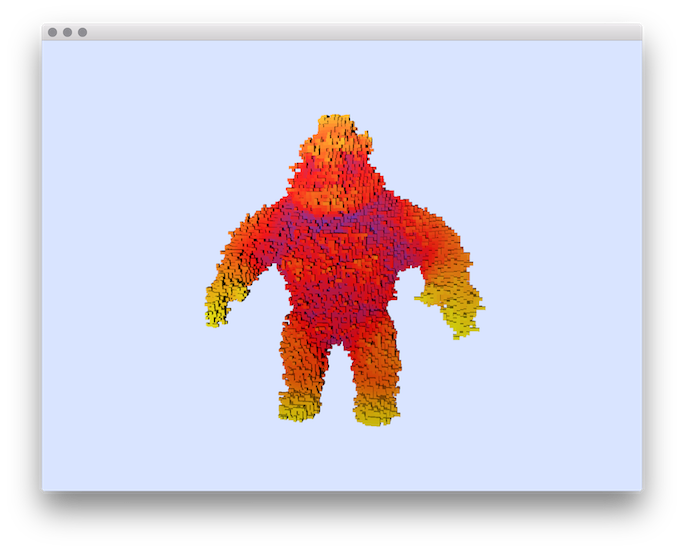
- See also
- related article: Coeurjolly, D.; Lachaud, J.O; Levallois, J., (2013). Integral based Curvature Estimators in Digital Geometry. DGCI 2013. Retrieved from https://liris.cnrs.fr/publis/?id=5866
Usage: 3dCurvatureViewerNoise -i file.vol –radius 5 –mode mean –noise 0.5Allowed options are:
Positionals:
1 TEXT:FILE REQUIRED vol file (.vol, .longvol .p3d, .pgm3d and if DGTAL_WITH_ITK is selected: dicom, dcm, mha, mhd). For longvol, dicom, dcm, mha or mhd formats, the input values are linearly scaled between 0 and 255.
Options:
-h,--help Print this help message and exit
-i,--input TEXT:FILE REQUIRED vol file (.vol, .longvol .p3d, .pgm3d and if DGTAL_WITH_ITK is selected: dicom, dcm, mha, mhd). For longvol, dicom, dcm, mha or mhd formats, the input values are linearly scaled between 0 and 255.
-r,--radius FLOAT REQUIRED Kernel radius for IntegralInvariant
-k,--noise FLOAT=0.5 Level of Kanungo noise ]0;1[
-t,--threshold UINT=8 Min size of SCell boundary of an object
-l,--minImageThreshold INT=0 set the minimal image threshold to define the image object (object defined by the voxel with intensity belonging to ]minImageThreshold, maxImageThreshold ] ).
-u,--maxImageThreshold INT=255 set the maximal image threshold to define the image object (object defined by the voxel with intensity belonging to ]minImageThreshold, maxImageThreshold] ).
-m,--mode TEXT:{mean,gaussian,k1,k2,prindir1,prindir2,normal}=mean
type of output : mean, gaussian, k1, k2, prindir1, prindir2 or normal(default mean)
-o,--exportOBJ TEXT Export the scene to specified OBJ/MTL filename (extensions added).
-d,--exportDAT TEXT Export resulting curvature (for mean, gaussian, k1 or k2 mode) in a simple data file each line representing a surfel.
--exportOnly Used to only export the result without the 3d Visualisation (usefull for scripts).
-s,--imageScale FLOAT x 3 scaleX, scaleY, scaleZ: re sample the source image according with a grid of size 1.0/scale (usefull to compute curvature on image defined on anisotropic grid). Set by default to 1.0 for the three axis.
- "mean" for the mean curvature
- "gaussian" for the Gaussian curvature
- "k1" for the first principal curvature
- "k2" for the second principal curvature
- "prindir1" for the first principal curvature direction
- "prindir2" for the second principal curvature direction
- "normal" for the normal vector
Example: $ 3dCurvatureViewerNoise $DGtal/examples/samples/Al.100.vol -r 15 -m mean -k 0.5

resulting visualisation of mean curvature.
3dCurveViewer
Usage: 3dCurveViewer [options] inputAllowed options are :
Example:
You should obtain such a visualisation:
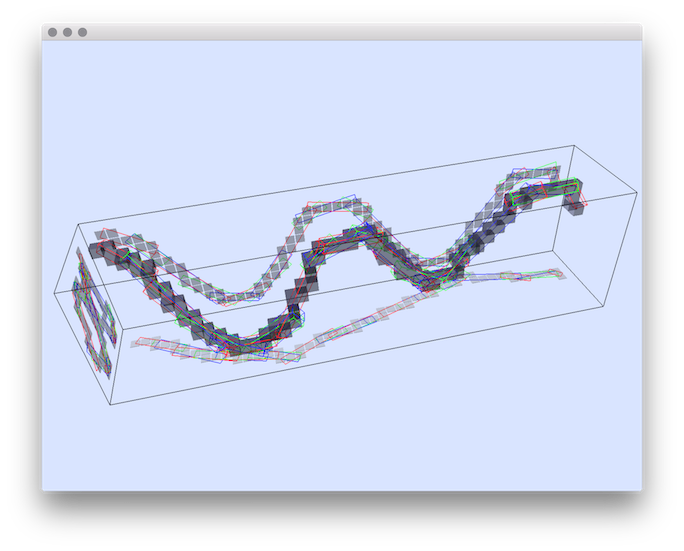
Positionals:
1 TEXT:FILE REQUIRED the name of the text file containing the list of 3D points (x y z per line).
Options:
-h,--help Print this help message and exit
-i,--input TEXT:FILE REQUIRED the name of the text file containing the list of 3D points (x y z per line).
-b,--box INT=0 specifies the the tightness of the bounding box around the curve with a given integer displacement <arg> to enlarge it (0 is tight)
-v,--viewBox TEXT:{WIRED,COLORED}=WIRED
displays the bounding box, <arg>=WIRED means that only edges are displayed, <arg>=COLORED adds colors for planes (XY is red, XZ green, YZ, blue).
-C,--curve3d displays the 3D curve.
-c,--curve2d displays the 2D projections of the 3D curve on the bounding box.
-3,--cover3d displays the 3D tangential cover of the curve.
-2,--cover2d displays the 2D projections of the 3D tangential cover of the curve
-n,--nbColors INT=3 sets the number of successive colors used for displaying 2d and 3d maximal segments (default is 3: red, green, blue)
-t,--tangent displays the tangents to the curve
$ 3dCurveViewer -C -b 1 -3 -2 -c ${DGtal}/examples/samples/sinus.dat
Definition ATu0v1.h:57

resulting visualisation of 3d curve with tangential cover.
- See also
- 3dCurveViewer.cpp
3dDisplaySurfelData
Usage: 3dDisplaySurfelData [OPTIONS] 1 [fixMaxColorValue] [fixMinColorValue]Allowed options are :
Example: To test this program we have first to generate a file containing a set of surfels with, for instance, their associated curvature values: Then, we can use this tool to display the set of surfel with their associated values:
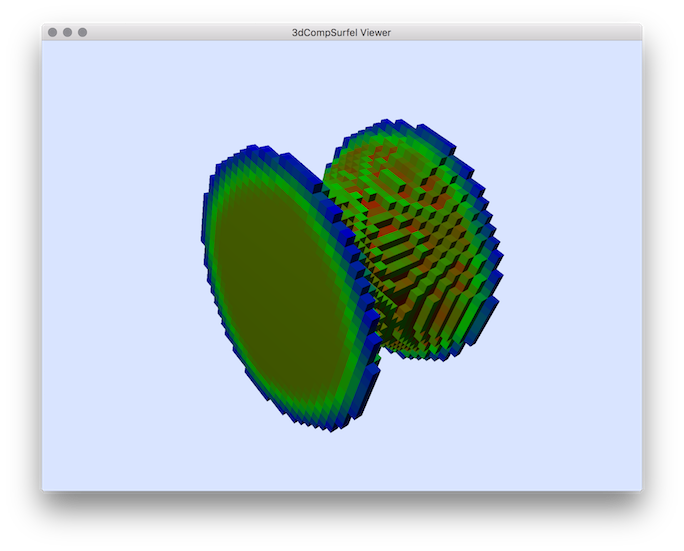
Positionals:
1 TEXT:FILE REQUIRED input file: sdp (sequence of discrete points with attribute)
Options:
-h,--help Print this help message and exit
-i,--input TEXT:FILE REQUIRED input file: sdp (sequence of discrete points with attribute)
-n,--noWindows Don't display Viewer windows.
-d,--doSnapShotAndExit TEXT save display snapshot into file.
--labelIndex UINT set the index of the label (by default set to 3)
--SDPindex UINT ... specify the sdp index (by default 0,1,2).
--fixMaxColorValue FLOAT fix manually the maximal color value for the scale error display (else the scale is set from the maximal value)
--fixMinColorValue FLOAT fix manually the maximal color value for the scale error display (else the scale is set from the minimal value)
$ 3dCurvatureViewer -i $DGtal/examples/samples/cat10.vol -r 3 --exportOnly -d curvatureCat10R3.dat
$ 3dDisplaySurfelData -i curvatureCat10R3.dat
You should obtain such a result:

resulting visualisation of surfel with their associated values.
- See also
- 3dDisplaySurfelData.cpp, CompSurfelData
3dHeightMapViewer
Usage: 3dImageViewer [options] inputAllowed options are :
Example: You should obtain such a result:
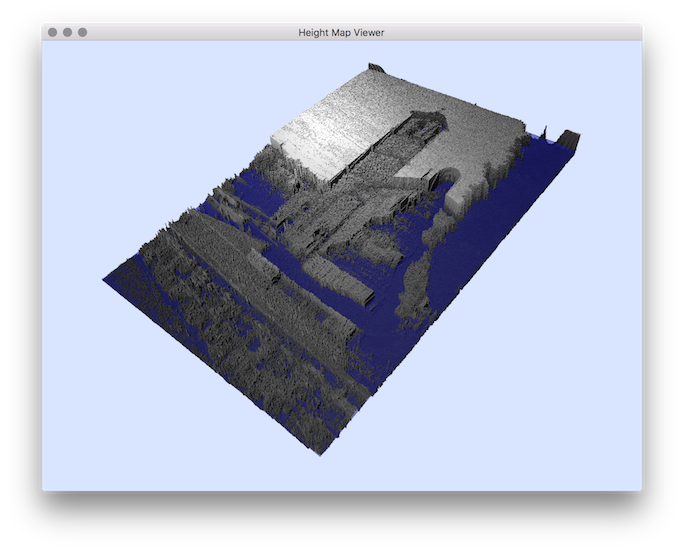
Positionals:
1 TEXT:FILE REQUIRED 2d input image representing the height map (given as grayscape image cast into 8 bits).
Options:
-h,--help Print this help message and exit
-i,--input TEXT:FILE REQUIRED 2d input image representing the height map (given as grayscape image cast into 8 bits).
-s,--scale FLOAT set the scale of the maximal level. (default 1.0)
-c,--colorMap define the heightmap color with a pre-defined colormap (GradientColorMap)
-t,--colorTextureImage TEXT define the heightmap color from a given color image (32 bits image).
$ visualisation/3dHeightMapViewer ${DGtal}/examples/samples/church.pgm -s 0.2

resulting heightmap visualisation.
- See also
- 3dHeightMapViewer.cpp
3dImageViewer
Usage: 3dImageViewer [OPTIONS] 1 [s]Allowed options are :
Example: With the image display you can also threshold the image and display a set of voxel: You should obtain such a result:

Positionals:
1 TEXT:FILE REQUIRED vol file (.vol, .longvol .p3d, .pgm3d and if DGTAL_WITH_ITK is selected: dicom, dcm, mha, mhd). For longvol, dicom, dcm, mha or mhd formats, the input values are linearly scaled between 0 and 255.
s TEXT display a set of discrete points (.sdp)
Options:
-h,--help Print this help message and exit
-i,--input TEXT:FILE REQUIRED vol file (.vol, .longvol .p3d, .pgm3d and if DGTAL_WITH_ITK is selected: dicom, dcm, mha, mhd). For longvol, dicom, dcm, mha or mhd formats, the input values are linearly scaled between 0 and 255.
--grid draw slice images using grid mode.
--intergrid draw slice images using inter grid mode.
--emptyMode remove the default boundingbox display.
--thresholdImage threshold the image to define binary shape
--thresholdMin INT=0 threshold min to define binary shape
--thresholdMax INT=255 threshold maw to define binary shape
--displaySDP TEXT display a set of discrete points (.sdp)
--SDPindex UINT x 3 specify the sdp index.
--SDPball FLOAT=0 use balls to display a set of discrete points (if not set to 0 and used with displaySDP option).
--displayMesh TEXT display a Mesh given in OFF or OFS format.
--displayDigitalSurface display the digital surface instead of display all the set of voxels (used with thresholdImage or displaySDP options)
--colorizeCC colorize each Connected Components of the surface displayed by displayDigitalSurface option.
-c,--colorSDP UINT x 4 set the color discrete points: r g b a
--colorMesh UINT x 4 set the color of Mesh (given from displayMesh option) : r g b a
-x,--scaleX FLOAT=1 set the scale value in the X direction
-y,--scaleY FLOAT=1 set the scale value in the Y direction
-z,--scaleZ FLOAT=1 set the scale value in the Z direction
--rescaleInputMin INT=0 min value used to rescale the input intensity (to avoid basic cast into 8 bits image).
--rescaleInputMax INT=255 max value used to rescale the input intensity (to avoid basic cast into 8 bits image).
-t,--transparency UINT=? change the default transparency
3dImageViewer $DGtal/examples/samples/lobster.vol --thresholdImage -m 180

resulting visualisation of 3d image with thresholded set of voxels.
- See also
- 3dImageViewer.cpp
3dImplicitSurfaceExtractorBy4DExtension
Usage: 3dImplicitSurfaceExtractorBy4DExtension [options] inputAllowed options are :Example:
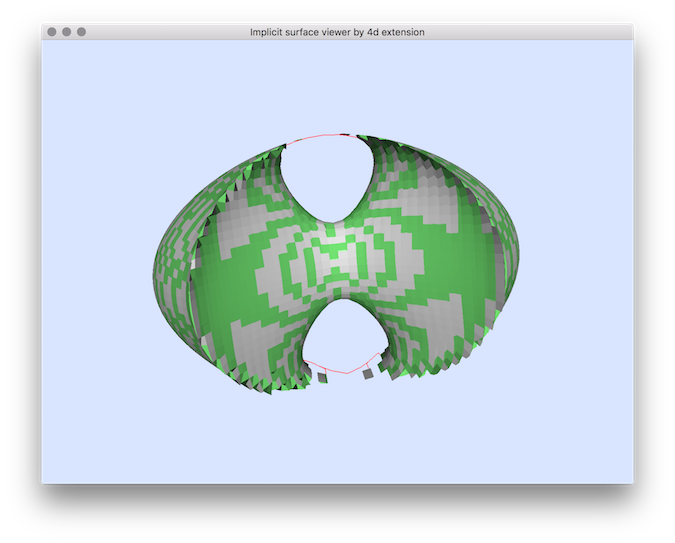
-h [ --help ] display this message
-p [ --polynomial ] arg the implicit polynomial whose
zero-level defines the shape of
interest.
-a [ --minAABB ] arg (=-10) the min value of the AABB bounding box
(domain)
-A [ --maxAABB ] arg (=10) the max value of the AABB bounding box
(domain)
-g [ --gridstep ] arg (=1) the gridstep that defines the
digitization (often called h).
-t [ --timestep ] arg (=9.9999999999999995e-07)
the gridstep that defines the
digitization in the 4th dimension
(small is generally a good idea,
default is 1e-6).
-P [ --project ] arg (=Newton) defines the projection: either No or
Newton.
-e [ --epsilon ] arg (=9.9999999999999995e-08)
the maximum precision relative to the
implicit surface.
-n [ --max_iter ] arg (=500) the maximum number of iteration in the
Newton approximation of F=0.
-v [ --view ] arg (=Normal) specifies if the surface is viewed as
is (Normal) or if places close to
singularities are highlighted
(Singular).
3dImplicitSurfaceExtractorBy4DExtension -p "-0.9*(y^2+z^2-1)^2-(x^2+y^2-1)^3" -g 0.06125 -a -2 -A 2 -v Singular -t 0.02
You could also use other implicit surfaces:
- whitney : x^2-y*z^2
- 4lines : x*y*(y-x)*(y-z*x)
- cone : z^2-x^2-y^2
- simonU : x^2-z*y^2+x^4+y^4
- cayley3 : 4*(x^2 + y^2 + z^2) + 16*x*y*z - 1
- crixxi : -0.9*(y^2+z^2-1)^2-(x^2+y^2-1)^3

resulting visualisation.
3dImplicitSurfaceExtractorByThickening
Usage: 3dImplicitSurfaceExtractorByThickening [options] inputAllowed options are :
Example: You should obtain such a result:
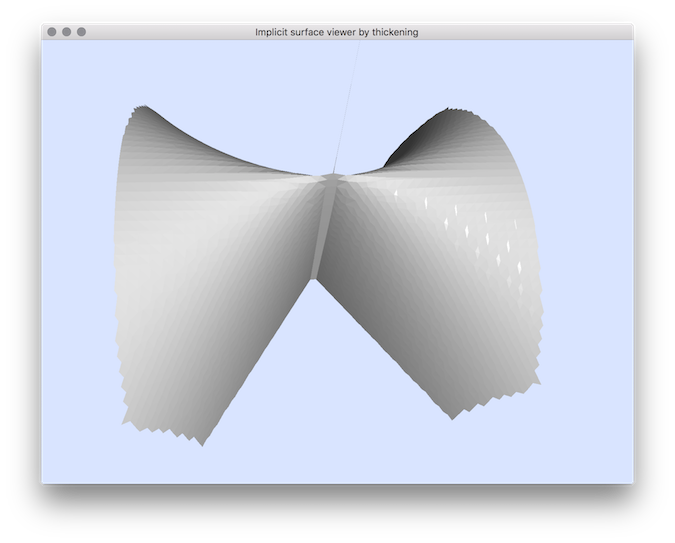 You could also use other implicit surfaces:
You could also use other implicit surfaces:
ositionals:
1 TEXT REQUIRED the implicit polynomial whose zero-level defines the shape of interest.
Options:
-h,--help Print this help message and exit
-p,--polynomial TEXT REQUIRED the implicit polynomial whose zero-level defines the shape of interest.
-a,--minAABB FLOAT=-10 the min value of the AABB bounding box (domain)
-A,--maxAABB FLOAT=10 the max value of the AABB bounding box (domain)
-g,--gridstep FLOAT=1 the gridstep that defines the digitization (often called h).
-t,--thickness FLOAT=0.01 the thickening parameter for the implicit surface.
-P,--project TEXT:{No,Newton}=Newton defines the projection: either No or Newton.
-e,--epsilon FLOAT=1e-06 the maximum precision relative to the implicit surface in the Newton approximation of F=0.
-n,--max_iter UINT=500 the maximum number of iteration in the Newton approximation of F=0.
-o,--obj TEXT OBJ export filename.
-v,--view TEXT:{Singular,Normal,Hide}=Normal
specifies if the surface is viewed as is (Normal) or if places close to singularities are highlighted (Singular), or if unsure places should not be displayed (Hide).
3dImplicitSurfaceExtractorByThickening "x^2-y*z^2" -g 0.1 -a -2 -A 2 -v Singular

resulting visualisation.
- whitney : x^2-y*z^2
- 4lines : x*y*(y-x)*(y-z*x)
- cone : z^2-x^2-y^2
- simonU : x^2-z*y^2+x^4+y^4
- cayley3 : 4*(x^2 + y^2 + z^2) + 16*x*y*z - 1
- crixxi : -0.9*(y^2+z^2-1)^2-(x^2+y^2-1)^3
3dImplicitSurfaceExtractorByThickening -a -2 -A 2 "((y^2+z^2-1)^2-(x^2+y^2-1)^3)*(y*(x-1)^2-z*(x+1))^2" -g 0.025 -e 1e-6 -n 50000 -v Singular -t 0.5 -P Newton
3dImplicitSurfaceExtractorByThickening -a -2 -A 2 "(x^5-4*z^3*y^2)*((x+y)^2-(z-x)^3)" -g 0.025 -e 1e-6 -n 50000 -v Singular -t 0.05 -P Newton
3dSDPViewer
Usage: 3dSDPViewer [OPTIONS] 1 [f] [lineSize] [filterVectors]Allowed options are :
Basic example: You can display a set of 3D points with sphere primitive and lines: You should obtain such a result:
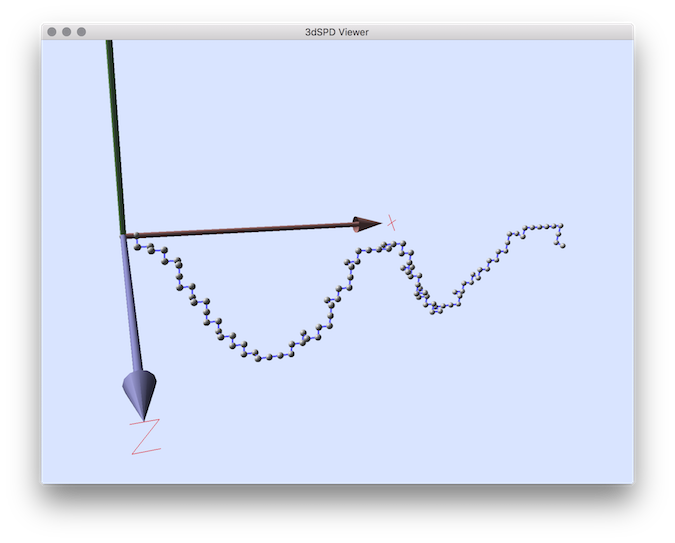 Example with interactive selection :This tool can be useful to recover the index of selected voxel:
Example with interactive selection :This tool can be useful to recover the index of selected voxel:
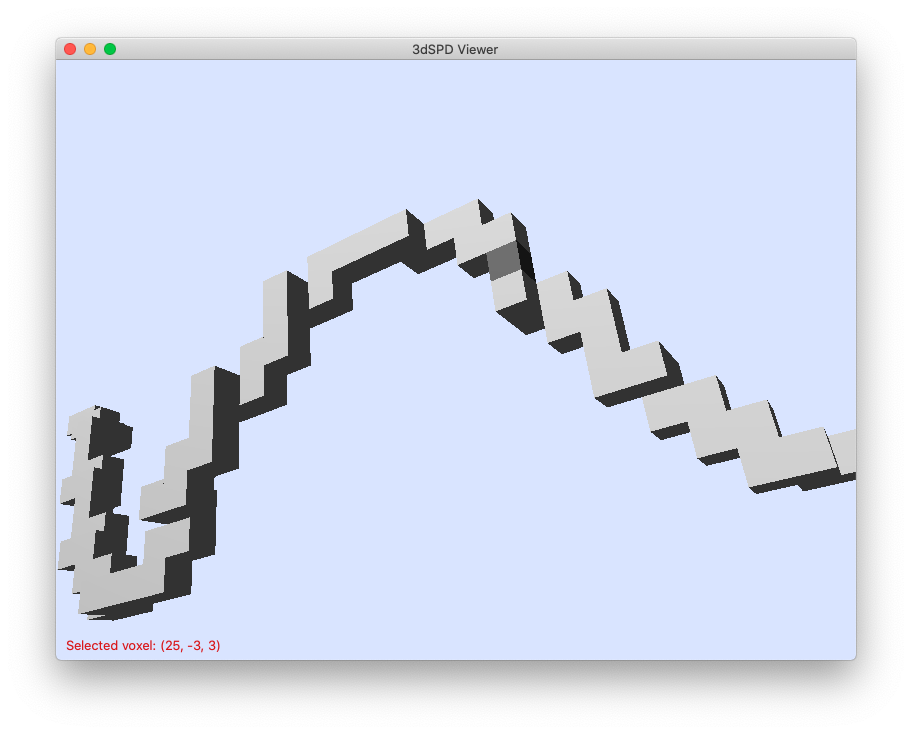 Visualization of large point set If you need to display an important number of points, you can use the primitive sphere instead voxel. You will obtain such type of a visualization:
Visualization of large point set If you need to display an important number of points, you can use the primitive sphere instead voxel. You will obtain such type of a visualization:
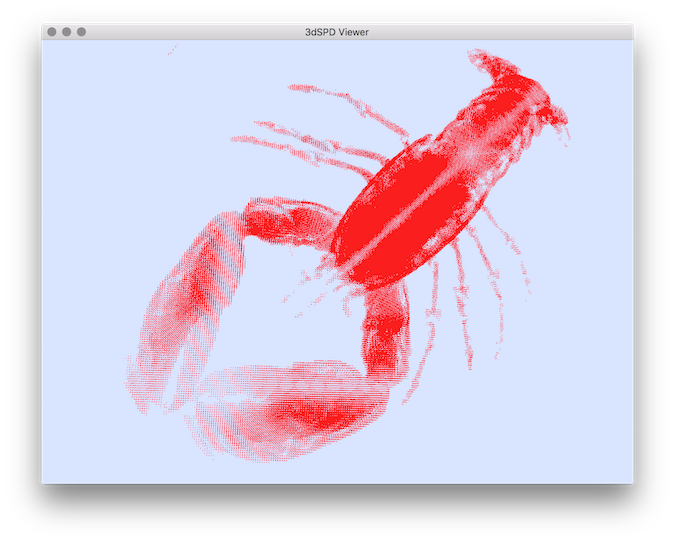
Positionals:
1 TEXT:FILE REQUIRED input file: sdp (sequence of discrete points).
Options:
-h,--help Print this help message and exit
-i,--input TEXT:FILE REQUIRED input file: sdp (sequence of discrete points).
--SDPindex UINT x 3 specify the sdp index (by default 0,1,2).
-c,--pointColor INT x 4 set the color of points: r g b a.
-l,--lineColor INT x 4 set the color of line: r g b a.
-m,--addMesh TEXT append a mesh (off/obj) to the point set visualization.
--customColorMesh UINT x 4 set the R, G, B, A components of the colors of the mesh faces (mesh added with option --addMesh).
--customAlphaMesh UINT set single alpha(A) components of the colors of the mesh faces (mesh added with option --addMesh).
--importColors import point colors from the input file (R G B colors should be by default at index 3, 4, 5).
--setColorsIndex UINT x 3 Needs: --importColors
customize the index of the imported colors in the source file (used by --importColor). By default the initial indexes are 3, 4, 5.
--importColorLabels import color labels from the input file (label index should be by default at index 3).
--setColorLabelIndex UINT=3 customize the index of the imported color labels in the source file (used by -importColorLabels).
-f,--filter FLOAT=100 filter input file in order to display only the [arg] percent of the input 3D points (uniformly selected).
--noPointDisplay usefull for instance to only display the lines between points.
--drawLines draw the line between discrete points.
-x,--scaleX FLOAT=1 set the scale value in the X direction
-y,--scaleY FLOAT=1 set the scale value in the Y direction
-z,--scaleZ FLOAT=1 set the scale value in the Z direction
--lineSize FLOAT=0.2 defines the line size (used when the --drawLines or --drawVectors option is selected).
-p,--primitive TEXT:{voxel,glPoints,sphere}=voxel
set the primitive to display the set of points.
-v,--drawVectors TEXT SDP vector file: draw a set of vectors from the given file (each vector are determined by two consecutive point given, each point represented by its coordinates on a single line.
-u,--unitVector FLOAT=0 specifies that the SDP vector file format (of --drawVectors option) should be interpreted as unit vectors (each vector position is be defined from the input point (with input order) with a constant norm defined by [arg]).
--filterVectors FLOAT=100 filters vector input file in order to display only the [arg] percent of the input vectors (uniformly selected, to be used with option --drawVectors else no effect).
$ 3DSDPViewer $DGtal/tests/samples/sinus3D.dat -p sphere --drawLines --lineSize 5

Resulting visualization.
$ 3dSDPViewer $DGtal/tests/samples/sinus3D.dat
By clicking on a voxel:


- See also
- 3DSDPViewer.cpp
3dVolBoundaryViewer
The mode specifies if you wish to see surface elements (BDRY), the inner voxels (INNER) or the outer voxels (OUTER) that touch the boundary.Usage: 3dVolBoundaryViewer -i [input]Allowed options are :
Example: You should obtain such a result:
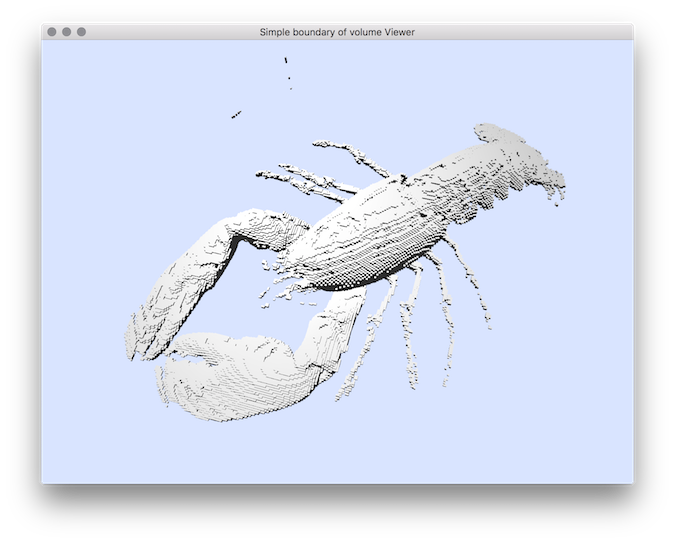
Positionals:
1 TEXT:FILE REQUIRED vol file (.vol, .longvol .p3d, .pgm3d and if DGTAL_WITH_ITK is selected: dicom, dcm, mha, mhd). For longvol, dicom, dcm, mha or mhd formats, the input values are linearly scaled between 0 and 255.
Options:
-h,--help Print this help message and exit
-i,--input TEXT:FILE REQUIRED vol file (.vol, .longvol .p3d, .pgm3d and if DGTAL_WITH_ITK is selected: dicom, dcm, mha, mhd). For longvol, dicom, dcm, mha or mhd formats, the input values are linearly scaled between 0 and 255.
-m,--thresholdMin INT=0 threshold min (excluded) to define binary shape.
-M,--thresholdMax INT=255 threshold max (included) to define binary shape.
--mode TEXT:{INNER,OUTER,BDRY}=INNER set mode for display: INNER: inner voxels, OUTER: outer voxels, BDRY: surfels
OUTER: outer voxels, BDRY: surfels
3dVolBoundaryViewer $DGtal/examples/samples/lobster.vol -m 60

Resulting visualization.
- See also
- 3dVolBoundaryViewer.cpp
3dVolViewer
The mode specifies if you wish to see surface elements (BDRY), the inner voxels (INNER) or the outer voxels (OUTER) that touch the boundary.Usage: 3dVolViewer [input]Allowed options are :
Example: You should obtain such a result:
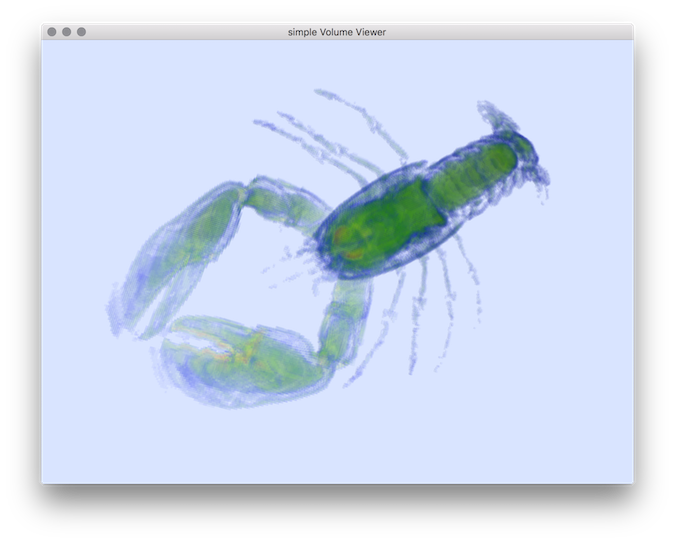
Positionals:
1 TEXT:FILE REQUIRED vol file (.vol, .longvol .p3d, .pgm3d and if DGTAL_WITH_ITK is selected: dicom, dcm, mha, mhd). For longvol, dicom, dcm, mha or mhd formats, the input values are linearly scaled between 0 and 255.
Options:
-h,--help Print this help message and exit
-i,--input TEXT:FILE REQUIRED vol file (.vol, .longvol .p3d, .pgm3d and if DGTAL_WITH_ITK is selected: dicom, dcm, mha, mhd). For longvol, dicom, dcm, mha or mhd formats, the input values are linearly scaled between 0 and 255.
-m,--thresholdMin INT=0 threshold min (excluded) to define binary shape.
-M,--thresholdMax INT=255 threshold max (included) to define binary shape.
--rescaleInputMin INT=0 min value used to rescale the input intensity (to avoid basic cast into 8 bits image).
--rescaleInputMax INT=255 max value used to rescale the input intensity (to avoid basic cast into 8 bits image).
-n,--numMaxVoxel UINT set the maximal voxel number to be displayed.
--displayMesh TEXT display a Mesh given in OFF or OFS format.
--colorMesh UINT ... set the color of Mesh (given from displayMesh option) : r g b a
-d,--doSnapShotAndExit save display snapshot into file. Notes that the camera setting is set by default according the last saved configuration (use SHIFT+Key_M to save current camera setting in the Viewer3D). If the camera setting was not saved it will use the default camera setting.
-t,--transparency UINT=255 change the defaukt transparency
$ 3dVolViewer $DGtal/examples/samples/lobster.vol -m 60 -t 10

Resulting visualization.
- See also
- 3dVolViewer.cpp
displayContours
Usage: displayContours [options] -i <fileName>Allowed options are :
Example: In this example we show how to display of a set of contours extracted in a single image. The first step is to extract a set contours by using the toolThen, we display the set of contours with the background images (you need to have compiled DGTal with the options (-DWITH_MAGICK=true and -DDGTAL_WITH_CAIRO=true) :You should obtain such a result:
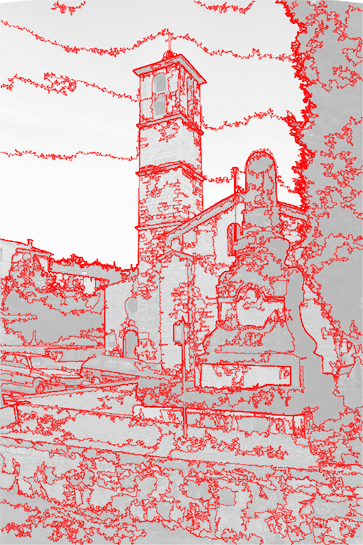
Positionals:
1 TEXT:FILE REQUIRED input FreemanChain file name
Options:
-h,--help Print this help message and exit
-i,--input TEXT:FILE input FreemanChain file name
-o,--outputFile TEXT save output file automatically according the file format extension.
--SDP TEXT:FILE Import a contour as a Sequence of Discrete Points (SDP format)
--SFP TEXT:FILE mport a contour as a Sequence of Floating Points (SFP format)
--drawContourPoint FLOAT <size> display contour points as disk of radius <size>
--fillContour fill the contours with default color (gray)
--lineWidth FLOAT Define the linewidth of the contour (SDP format)
-f,--drawPointOfIndex UINT Draw the contour point of index.
--pointSize FLOAT <size> Set the display point size of the point displayed by drawPointofIndex option (default 2.0)
--noXFIGHeader BOOLEAN to exclude xfig header in the resulting output stream (no effect with option -outputFile).
--withProcessing TEXT:{MS,FP,MLP} Processing (used only when the input is a Freeman chain (--input)):
DSS segmentation {DSS}
Maximal segments {MS}
Faithful Polygon {FP}
Minimum Length Polygon {MLP}
-v,--displayVectorField TEXT Add the display of a vector field represented by two floating coordinates. Each vector is displayed starting from the corresponding contour point coordinates.
--scaleVectorField FLOAT=1 set the scale of the vector field (default 1) (used with --displayVectorField).
--vectorFieldIndex UINT=[0,1] x 2 specify the vector field index (by default 0,1) (used with --displayVectorField).
--vectorFromAngle UINT specify that the vectors are defined from an angle value represented at the given index (by default 0) (used with --displayVectorField).
--rotateVectorField apply a CCW rotation of 90° (used with --displayVectorField).
--outputStreamEPS specify eps for output stream format.
--outputStreamSVG specify svg for output stream format.
--outputStreamFIG specify fig for output stream format.
--invertYaxis Needs: --SDP invertYaxis invert the Y axis for display contours (used only with --SDP)
--backgroundImage TEXT:FILE backgroundImage <filename> : display image as background
--alphaBG FLOAT=1 alphaBG <value> 0-1.0 to display the background image in transparency (default 1.0), (transparency works only if cairo is available)
--scale FLOAT=1 scale <value> 1: normal; >1 : larger ; <1 lower resolutions)
$ img2freeman $DGtal/examples/samples/church.pgm -R 0 20 255 -s 200 > church.fc
$ displayContours church.fc --backgroundImage $DGtal/examples/samples/church.png --alphaBG 0.75 --outputFile church.pdf

Resulting visualization.
- See also
- displayContours.cpp
meshViewer
Usage: meshViewer [input]Allowed options are :
Example: You should obtain such a result:
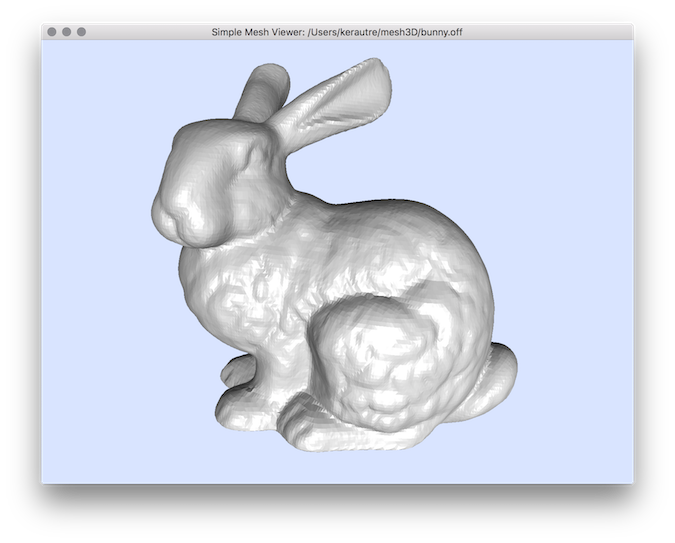
Positionals:
1 TEXT:FILE ... REQUIRED inputFileNames.off files (.off), or OFS file (.ofs)
Options:
-h,--help Print this help message and exit
-i,--input TEXT:FILE ... REQUIRED inputFileNames.off files (.off), or OFS file (.ofs)
-x,--scaleX FLOAT set the scale value in the X direction (default 1.0)
-y,--scaleY FLOAT set the scale value in the y direction (default 1.0)
-z,--scaleZ FLOAT set the scale value in the z direction (default 1.0)
--minLineWidth FLOAT=1.5 set the min line width of the mesh faces (default 1.5)
--customColorMesh UINT ... set the R, G, B, A components of the colors of the mesh faces and eventually the color R, G, B, A of the mesh edge lines (set by default to black).
--customAlphaMesh UINT ... set the alpha components of the colors of the mesh faces (can be applied for each mesh).
--customColorSDP UINT x 4 set the R, G, B, A components of the colors of the sdp view
-f,--displayVectorField TEXT display a vector field from a simple sdp file (two points per line)
--vectorFieldIndex UINT x 6 specify special indices for the two point coordinates (instead usinf the default indices: 0 1, 2, 3, 4, 5)
--customLineColor UINT x 4 set the R, G, B components of the colors of the lines displayed from the --displayVectorField option (red by default).
--SDPradius FLOAT=0.5 change the ball radius to display a set of discrete points (used with displaySDP option)
-s,--displaySDP TEXT add the display of a set of discrete points as ball of radius 0.5.
-A,--addAmbientLight FLOAT add an ambient light for better display (between 0 and 1).
-b,--customBGColor UINT x 3 set the R, G, B components of the colors of the background color.
-d,--doSnapShotAndExit TEXT save display snapshot into file. Notes that the camera setting is set by default according the last saved configuration (use SHIFT+Key_M to save current camera setting in the Viewer3D). If the camera setting was not saved it will use the default camera setting.
-l,--fixLightToScene Fix light source to scence instead to camera
-n,--invertNormal invert face normal vectors.
-v,--drawVertex draw the vertex of the mesh
$ meshViewer bunny.off

Resulting visualization.
- See also
- meshViewer.cpp
patternTriangulation
Usage: patternTriangulation -a 5 -b 8Allowed options are :Example: Result: a=5, b=8, d=1
Options:
-h,--help Print this help message and exit
-a,--aparam INT REQUIRED pattern a parameter
-b,--bparam INT REQUIRED pattern b parameter
-d,--delta INT number of repetitions
-t,--triangulation TEXT=CH output:
Closest-point Delaunay triangulation {CDT}
Farthest-point Delaunay triangulation {FDT}
Convex hull {CH}
$ patternTriangulation -a 5 -b 8
- See also
- patternTriangulation.cpp
volscope
Usage: volscope [options] –input <fileName>Allowed options are :
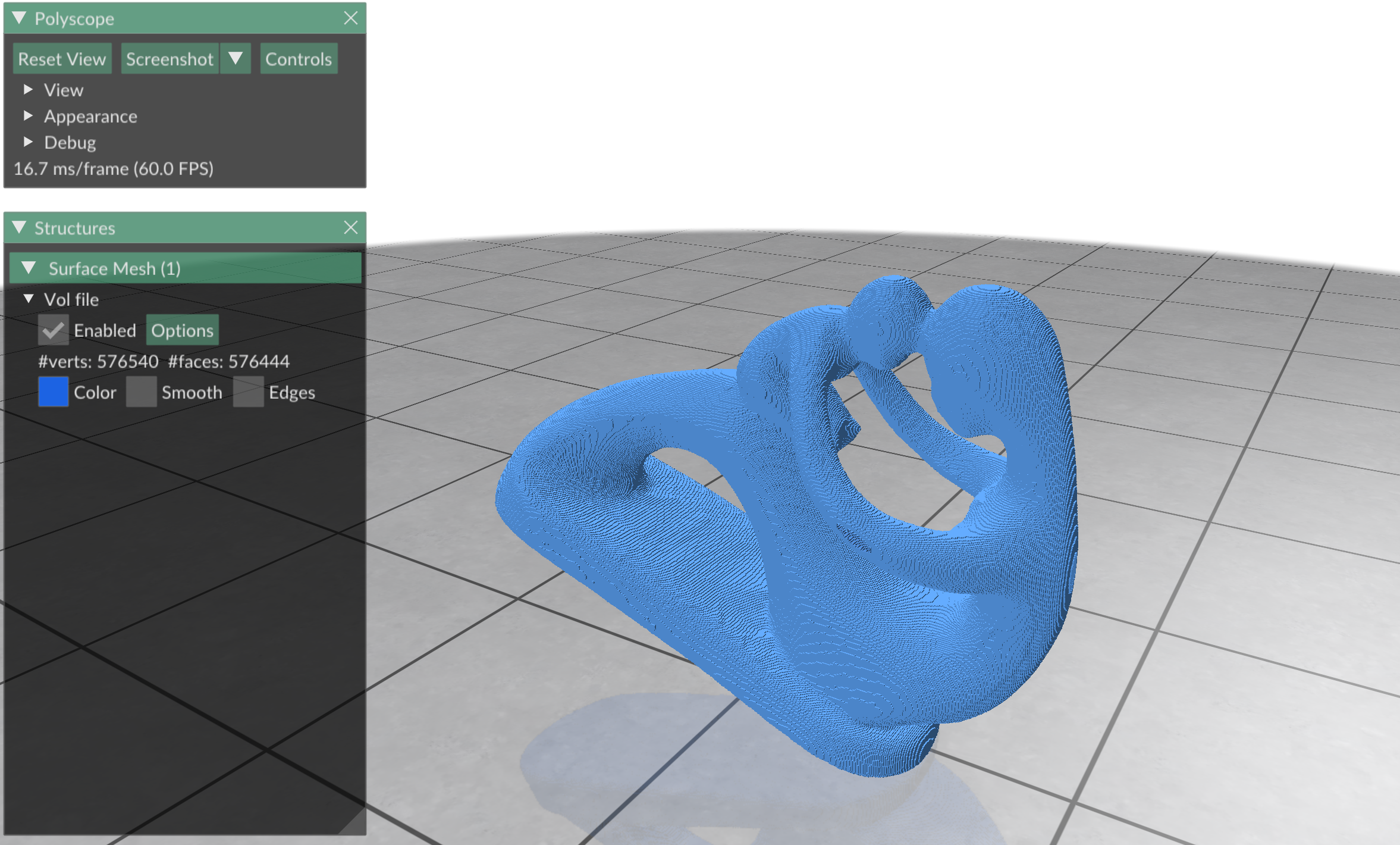
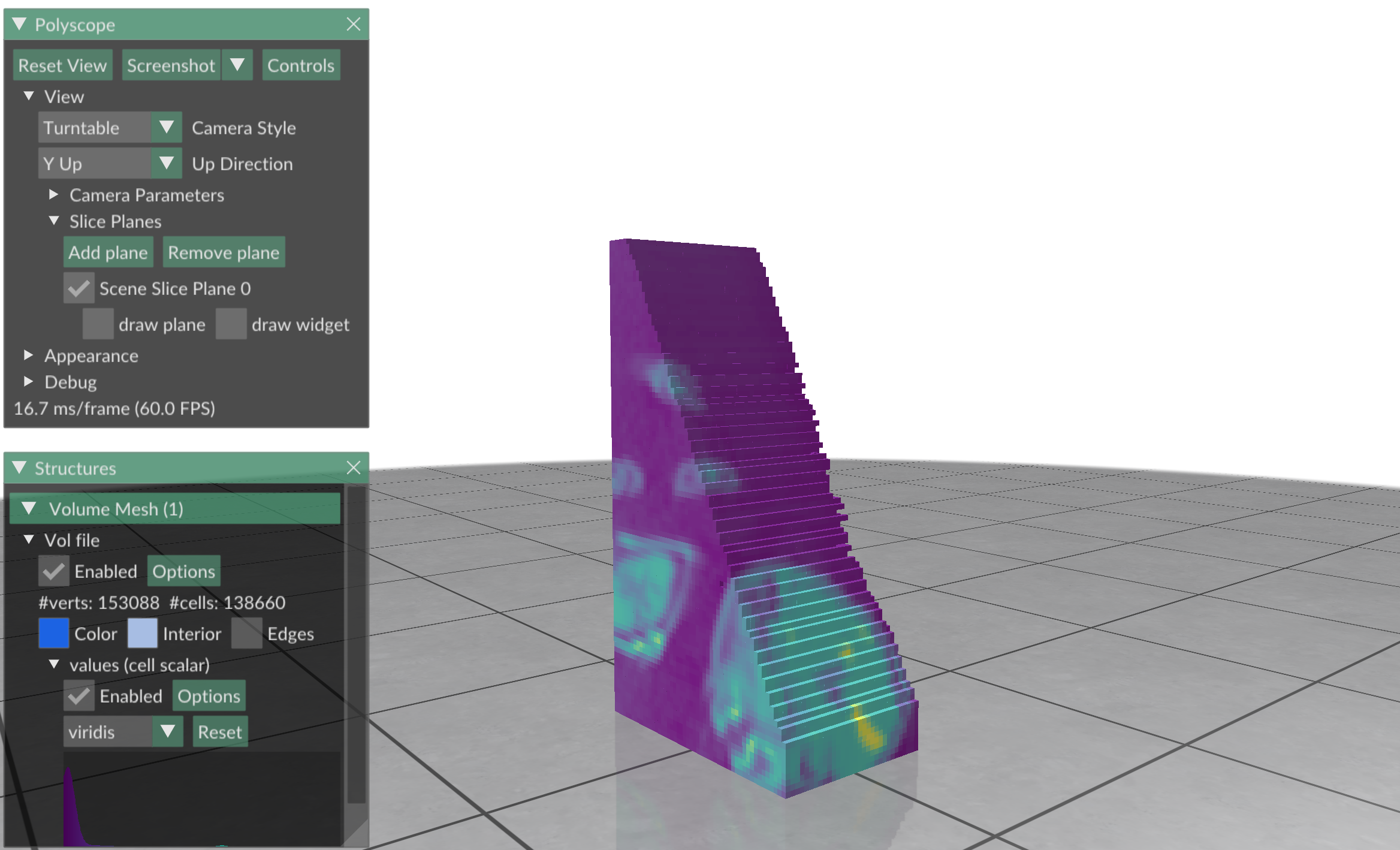
Usage: ./volscope [OPTIONS] 1
Positionals:
1 TEXT:FILE REQUIRED Input vol file.
Options:
-h,--help Print this help message and exit
-i,--input TEXT:FILE REQUIRED Input vol file.
--volumetricMode Activate the volumetric mode instead of the isosurface visualization.
--point-cloud-only In the volumetric mode, visualize the vol file as a point cloud instead of an hex mesh (default: false)
-m, --min INT For isosurface visualization and voxel filtering, specifies the threshold min (excluded) (default: 0).
-M, --max INT For isosurface visualization and voxel filtering, specifies the threshold max (included) (default: 255).

Default visualization mode.

Volumetric visualization using polyscope slice planes.